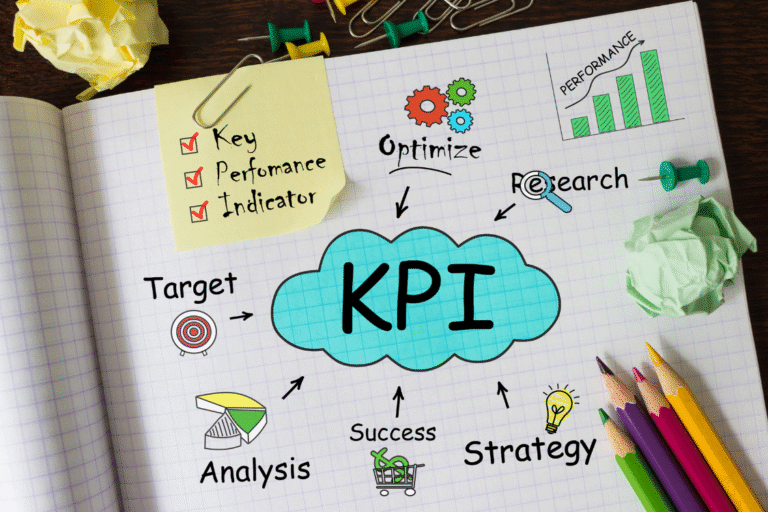A successful sale depends on structure, consistency, and measurable insight. Focusing on three key performance indicators (KPIs)—the listing date, qualified leads, and offers received—helps you monitor progress at every stage of the selling small business KPIs process.
Reviewing these KPIs weekly shows where your sales growth rate is improving and where strategic adjustments may be needed. Tracking the right sales KPIs over time helps identify patterns in conversion rate, recurring revenue, and monthly recurring revenue, giving you a clearer view of long-term stability and buyer interest.
Consistent KPI tracking also builds transparency, showing potential buyers how steady customer spending contributes to predictable performance. When every decision is based on verified data rather than assumptions, you move through the sale with greater focus, accuracy, and confidence.
What Are KPIs and Why They Matter
Key performance indicators (KPIs) are measurable data points that help assess how well business goals are being met. They translate complex information into understandable metrics that reflect sales performance and overall financial health.
Effective key performance indicators KPIs connect daily actions to larger business objectives. They follow the SMART approach—specific, measurable, achievable, relevant, and time-bound—so sellers can interpret data clearly and adjust strategy when needed.
What are KPIs in a business sale?
In a business sale, key performance indicators (KPIs) are reference points for tracking performance across each stage, from listing preparation to buyer negotiations. They help reveal whether marketing campaigns, pricing strategies, and outreach are achieving the desired results. Using these indicators enables sellers to make informed, data-based decisions about timing, value, and next steps.
There are generally two types of KPIs: lagging indicators and leading indicators. Lagging indicators measure results that have already occurred, such as total sales revenue, net profit margin, or gross profit margin. Leading indicators measure activities that help predict future performance, such as qualified leads, conversion rates, or buyer engagement.
A study published in Harvard Business Review (Cespedes & Marsh, 2017) found that many organizations focus mainly on lagging indicators like closed deals or sales quotas while paying less attention to leading indicators that forecast what is likely to happen next. In the context of selling a business, tracking both types of KPIs gives a fuller picture of progress and helps sellers make adjustments early rather than reacting only after results appear.
Why weekly KPI reviews prevent surprises
Weekly reviews of small business KPIs help maintain awareness of ongoing trends. They make it easier to identify shifts in sales data or buyer engagement and coordinate timely responses. Consistent check-ins also keep sales managers, sales reps, and brokers aligned on common strategic objectives.

Core KPI #1 – Listing Date
The listing date marks the point when your business becomes publicly visible to potential buyers. It serves as a key milestone and reference for tracking later metrics. Before launch, confirm that all necessary financial documentation, such as gross profit margin, operating profit margin, and cash flow, is updated and accurate so buyers can properly evaluate the current performance.
| Timeline | Milestone |
|---|---|
| Week 1 | Finalize financial documentation and upload supporting materials |
| Week 2 | Listing goes live on chosen platforms |
| Week 3 | Begin tracking inquiries and qualified leads |
A defined launch date helps maintain accountability among your sales team and advisors. If delays occur, review missing details or incomplete financial data. An organized, on-time listing improves visibility and establishes a clear timeline for tracking progress.
Core KPI #2 – Qualified Leads
A qualified lead refers to a buyer who meets agreed financial and practical criteria. Tracking this KPI distinguishes serious prospects from general inquiries.
The qualification process often includes three stages: 1. Inquiry → 2. Vetting → 3. Qualified Lead. Using a customer relationship management (CRM) system to record buyer information, available capital, and background details improves consistency and helps ensure that each lead meets your buyer requirements.
Metrics such as the source of the lead and time to qualification can provide valuable insights into the efficiency of your sales funnel. When the number of qualified leads decreases, it may suggest that marketing efforts or sales strategies need refinement. Adjusting messaging or targeting can improve engagement, but it does not guarantee results.
Core KPI #3 – Offers Received
The number of offers received indicates how buyers are responding to your business’s pricing and positioning. Written offers, or Letters of Intent (LOIs), are often used to gauge buyer commitment. Tracking this KPI can reveal whether your valuation and presentation align with market expectations.
If offers remain limited, consider revisiting pricing assumptions or clarifying financial presentation. Transparency in accounts receivable turnover, average purchase value, and other financial metrics can make it easier for buyers to evaluate information. Demonstrating a reliable customer retention rate, Net Promoter Score, or customer lifetime value may also enhance buyer confidence without guaranteeing specific outcomes.
| Symptom | Possible Cause | Potential Adjustment |
|---|---|---|
| Few offers | Pricing may exceed market expectations | Re-examine valuation data and comparable sales |
| Many inquiries, no offers | Presentation lacks clarity | Improve listing materials and emphasize accurate figures |
Regularly assessing this KPI helps sellers understand how total revenue, average revenue, and profit margins compare to market benchmarks, supporting more informed negotiation.

The Power of Weekly Tracking
Weekly tracking encourages consistency. Scheduling a brief review, such as every Friday, helps teams stay coordinated and responsive.
During each session, review the status of the three core KPIs: listing status, qualified leads, and offers. Discuss realistic adjustments to strategy or marketing campaigns that may support a steadier revenue growth rate.
Regular meetings promote accountability and keep business leaders aware of progress. They also contribute to smoother business operations and better coordination among the sales team.
How to Use a KPI Progress Tracker
A KPI progress tracker helps organize data in one place. It simplifies tracking sales KPIs so you can interpret trends quickly. Even a basic table can reveal shifts in financial KPIs, sales data, and customer relationships.
| Week Ending | Listing Live (Yes/No) | Qualified Leads | Offers Received | Notes & Next Steps |
|---|---|---|---|---|
| Jan 12 | Yes | 3 | 0 | Expand marketing reach to attract new customers |
| Jan 19 | Yes | 5 | 1 | Review first offer and evaluate buyer readiness |
| Jan 26 | Yes | 6 | 2 | Schedule meetings with qualified prospects |
Review the tracker weekly with your team or broker. Watching how sales revenue, customers acquired, and average purchase value evolve can show patterns over time. Observing these shifts supports better planning for predictable revenue and helps ensure adequate funds to cover operating expenses during the sale.
Troubleshooting Common Roadblocks
Most business sales face slow periods or logistical setbacks. Identifying these trends through KPIs allows for timely, data-driven responses.
- Listing delays: Often caused by incomplete documentation or missing data. Confirm all materials before re-launching.
- Low-qualified leads: Reassess marketing efforts and buyer outreach. Adjusting ad placement or refining your business model can expand exposure without ensuring specific lead counts.
- Few offers: Evaluate pricing structure and presentation quality. Strengthening how you display financial KPIs and sales performance can improve perception among buyers.
Responding to issues based on evidence, not assumptions, helps maintain forward progress and supports steady revenue growth through closing.

Stay on Track and Sell with Confidence
A successful sale depends on structure, consistency, and measurable insight. Focusing on three key performance indicators—the listing date, qualified leads, and offers received—helps you monitor progress at every stage of the selling process.
Reviewing these KPIs weekly shows where your sales growth rate is improving and where strategic adjustments may be needed. Tracking the right sales KPIs over time helps identify patterns in conversion rate, recurring revenue, and monthly recurring revenue, giving you a clearer view of long-term stability and buyer interest.
Consistent KPI tracking also builds transparency, showing potential buyers how steady customer spending contributes to predictable performance. When every decision is based on verified data rather than assumptions, you move through the sale with greater focus, accuracy, and confidence.
Frequently Asked Questions
What are the KPIs for selling a small business?
They are measurable indicators, such as listing date, qualified leads, and offers received, that show how a sale is progressing over time.
How often should I review KPIs when selling my business?
Checking your small business KPIs weekly can help identify changes early and guide practical adjustments.
What counts as a qualified lead in business sales?
A qualified lead is a vetted buyer with verified financial capacity and a clear interest in purchasing the business.
How do offers reflect business performance?
Offers can indicate how market participants view valuation and presentation, but do not guarantee sale outcomes.
What is the best way to track progress during a sale?
Use a KPI tracker to log weekly data, review sales metrics, and keep your business goals aligned with actual results.
References
- Baquero, A. (2022). Net Promoter Score (NPS) and customer satisfaction: Relationship and efficient management. Sustainability, 14(4), 2011. https://doi.org/10.3390/su14042011
- Cespedes, F. V., & Marsh, R. (2017, August 22). Find the right metrics for your sales team. Harvard Business Review. https://www.hbs.edu/faculty/Pages/item.aspx?num=53314


